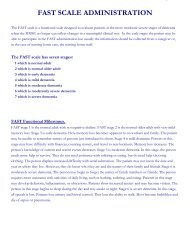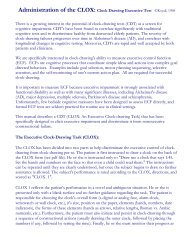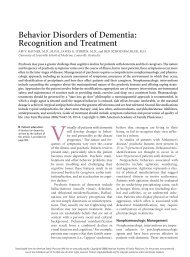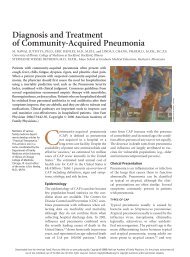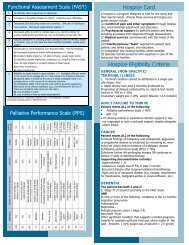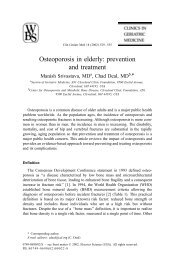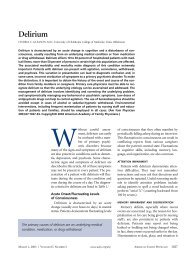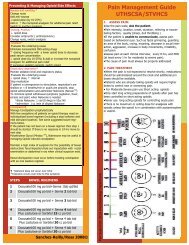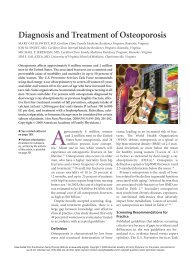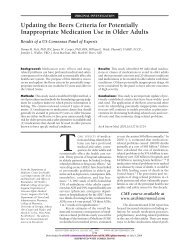the mini-cog - John A. Hartford Center of Excellence in Geriatrics ...
the mini-cog - John A. Hartford Center of Excellence in Geriatrics ...
the mini-cog - John A. Hartford Center of Excellence in Geriatrics ...
You also want an ePaper? Increase the reach of your titles
YUMPU automatically turns print PDFs into web optimized ePapers that Google loves.
INTERNATIONAL JOURNAL OF GERIATRIC PSYCHIATRY<br />
Int. J. Geriatr. Psychiatry 16, 216±222 (2001)<br />
THE MINI-COG: RECEIVER OPERATING<br />
CHARACTERISTICS WITH EXPERT AND NAIÈ VE<br />
RATERS<br />
JAMES SCANLAN 1,2 * AND SOO BORSON 1,2<br />
1 Alzheimer's Disease Research <strong>Center</strong>, University <strong>of</strong> Wash<strong>in</strong>gton, Seattle, WA, USA<br />
2 Department <strong>of</strong> Psychiatry and Behavioral Sciences, University <strong>of</strong> Wash<strong>in</strong>gton, Seattle, WA, USA<br />
ABSTRACT<br />
Background. As elderly populations grow, dementia detection <strong>in</strong> <strong>the</strong> community is <strong>in</strong>creas<strong>in</strong>gly needed. Exist<strong>in</strong>g<br />
screens are largely unused because <strong>of</strong> time and tra<strong>in</strong><strong>in</strong>g requirements. We developed <strong>the</strong> M<strong>in</strong>i-Cog, a brief dementia<br />
screen with high sensitivity, speci®city, and acceptability. Here we describe <strong>the</strong> development <strong>of</strong> its scor<strong>in</strong>g algorithm,<br />
its receiver operat<strong>in</strong>g characteristics (ROC), and <strong>the</strong> generalizability <strong>of</strong> its clock draw<strong>in</strong>g scor<strong>in</strong>g system.<br />
Sample and methods. A total <strong>of</strong> 249 multi-l<strong>in</strong>gual older adults were exam<strong>in</strong>ed. Scores on <strong>the</strong> three-item recall task<br />
and <strong>the</strong> clock draw<strong>in</strong>g task (CDT-CERAD version) were comb<strong>in</strong>ed to create an optimal algorithm. Receiver<br />
operat<strong>in</strong>g characteristics for seven alternatives were compared with those <strong>of</strong> <strong>the</strong> MMSE and <strong>the</strong> CASI us<strong>in</strong>g expert<br />
raters. To assess <strong>the</strong> CDT scor<strong>in</strong>g generalizability, 20 naõÈ ve raters, without explicit <strong>in</strong>structions or prior CDT<br />
exposure, scored 80 randomly selected clocks as `normal' or `abnormal' (20 from each <strong>of</strong> four CERAD categories).<br />
Results. An algorithm maximiz<strong>in</strong>g sensitivity and correct diagnosis was de®ned. Its ROC compared favorably with<br />
those <strong>of</strong> <strong>the</strong> MMSE and CASI. CDT concordance between naõÈ ve and tra<strong>in</strong>ed raters was 498% for normal,<br />
moderately and severely impaired clocks, but lower (60%) for mildly impaired clocks. Recalculation <strong>of</strong> <strong>the</strong> M<strong>in</strong>i-<br />
Cog's performance, assum<strong>in</strong>g that naõÈ ve raters would score all mildly impaired CDTs <strong>in</strong> <strong>the</strong> full sample as normal,<br />
reta<strong>in</strong>ed high sensitivity (97%) and speci®city (95%).<br />
Conclusion. The M<strong>in</strong>i-Cog algorithm performs well with simple clock scor<strong>in</strong>g techniques. The results suggest that<br />
<strong>the</strong> M<strong>in</strong>i-Cog may be used successfully by relatively untra<strong>in</strong>ed raters as a ®rst-stage dementia screen. Fur<strong>the</strong>r research<br />
is needed to characterize <strong>the</strong> M<strong>in</strong>i-Cog's utility when population dementia prevalences are low. Copyright # 2001<br />
<strong>John</strong> Wiley & Sons, Ltd.<br />
KEY WORDS Ð dementia screen<strong>in</strong>g; MMSE; clock draw<strong>in</strong>g; three-item recall; Cognitive Abilities Screen<strong>in</strong>g<br />
Instrument; naõÈ ve raters; language<br />
INTRODUCTION<br />
In a recent survey <strong>of</strong> 368 general practitioners, 82%<br />
believed that dementia screen<strong>in</strong>g <strong>of</strong> elderly persons<br />
is worthwhile, but only 24% rout<strong>in</strong>ely screened<br />
<strong>the</strong>ir own patients (Bush et al., 1997). The major<br />
barriers were lack <strong>of</strong> time (85%), fear <strong>of</strong> o€end<strong>in</strong>g<br />
patients (58%) and <strong>in</strong>adequacies <strong>in</strong> available tests<br />
(22%). When a formal <strong>cog</strong>nitive screen was used, it<br />
was usually <strong>the</strong> MMSE (Bush et al., 1997); if a<br />
* Correspondence to: J. Scanlan, Box 356560, University <strong>of</strong><br />
Wash<strong>in</strong>gton School <strong>of</strong> Medic<strong>in</strong>e, 1959 NE Paci®c Street,<br />
Seattle, WA 98195-6560, USA. Tel: 206-543-9600. Fax: 206-<br />
543-9520. E-mail: jscanlan@u.wash<strong>in</strong>gton.edu<br />
Contract/grant sponsor: National Institute on Ag<strong>in</strong>g (ADRC).<br />
Contract/grant sponsor: Health Resources and Services Ad<strong>m<strong>in</strong>i</strong>stration<br />
(Alzheimer's Disease Respite Project).<br />
short, simple screen such as clock draw<strong>in</strong>g could be<br />
shown to be e€ective, 93% would use it.<br />
Persuad<strong>in</strong>g doctors to adopt rout<strong>in</strong>e dementia<br />
screen<strong>in</strong>g thus appears to require a more e cient<br />
approach. The ideal <strong>in</strong>strument would be very<br />
brief, simple, sensitive, acceptable to older persons,<br />
and un<strong>in</strong>¯uenced by low education and language<br />
barriers that weaken <strong>the</strong> utility <strong>of</strong> most available<br />
screens. The M<strong>in</strong>i-Cog is a new <strong>in</strong>strument that<br />
comb<strong>in</strong>es a simple memory test with clock draw<strong>in</strong>g<br />
(CDT) and appears to ful®ll <strong>the</strong>se criteria. When<br />
used by expert raters, <strong>the</strong> M<strong>in</strong>i-Cog atta<strong>in</strong>ed 99%<br />
sensitivity and 93% speci®city <strong>in</strong> a split sample<br />
conta<strong>in</strong><strong>in</strong>g 50% demented persons, and required<br />
only 3 m<strong>in</strong>utes to ad<strong>m<strong>in</strong>i</strong>ster (Borson et al., 2000).<br />
However, it is unclear whe<strong>the</strong>r novice raters<br />
unfamiliar with <strong>cog</strong>nitive test<strong>in</strong>g will accurately<br />
Copyright # 2001 <strong>John</strong> Wiley & Sons, Ltd. Received 20 March 2000<br />
Accepted 13 June 2000
give <strong>the</strong> M<strong>in</strong>i-Cog <strong>in</strong> `real world' sett<strong>in</strong>gs. Its<br />
structure is simple enough to be used by community<br />
volunteers and health care personnel, provided<br />
its most vulnerable element, <strong>the</strong> CDT, can be<br />
scored correctly.<br />
Many CDT dementia screen<strong>in</strong>g systems have<br />
been proposed, with vary<strong>in</strong>g degrees <strong>of</strong> complexity<br />
(Watson et al., 1993; Shulman et al., 1986; Dastoor<br />
et al., 1991; Tuokko et al., 1992; Death et al., 1993).<br />
While all studies report <strong>the</strong> sensitivity and speci-<br />
®city <strong>of</strong> <strong>the</strong>ir proposed systems, cost±bene®t,<br />
measured <strong>in</strong> ease <strong>of</strong> use, is rarely exam<strong>in</strong>ed. If a<br />
scor<strong>in</strong>g system slightly improves sensitivity or<br />
speci®city but <strong>in</strong>creases costs <strong>in</strong> terms <strong>of</strong> complexity,<br />
<strong>in</strong>terpretation and tra<strong>in</strong><strong>in</strong>g, <strong>the</strong>n many CDT<br />
advantages are lost. As analog clock form and<br />
function are highly learned <strong>in</strong> most modern<br />
cultures, we believe that understand<strong>in</strong>g how to<br />
judge CDTs as `normal' and `abnormal' is <strong>in</strong>tuitively<br />
and widely understood. Therefore, if naõÈ ve<br />
raters gave <strong>the</strong>ir best estimates without an explicit<br />
scor<strong>in</strong>g system, <strong>the</strong>ir judgments should closely<br />
resemble expert decisions. If true, this could greatly<br />
facilitate CDT use as <strong>in</strong> community-based dementia<br />
screen<strong>in</strong>g e€orts.<br />
Similar reason<strong>in</strong>g has been applied to <strong>the</strong><br />
MMSE, and some studies show item subsets to<br />
perform as well as <strong>the</strong> complete scale. In one<br />
study, <strong>the</strong> four MMSE items that best discrim<strong>in</strong>ated<br />
normal controls from mild AD patients<br />
were two time orientation items (day, date) and<br />
two <strong>of</strong> <strong>the</strong> three conventional word recall items<br />
(`apple' and `penny'). Dementia discrim<strong>in</strong>ation<br />
us<strong>in</strong>g <strong>the</strong>se items alone was comparable to that <strong>of</strong><br />
<strong>the</strong> full MMSE (Fillenbaum et al., 1994). The<br />
MMSE three-item recall task was highly predictive<br />
<strong>of</strong> total score: 97% <strong>of</strong> subjects recall<strong>in</strong>g 0/3<br />
words had MMSE scores below <strong>the</strong> conventional<br />
cut-o€ po<strong>in</strong>t for screen<strong>in</strong>g (423), while 86% <strong>of</strong><br />
those recall<strong>in</strong>g 1±3 words scored 524 (Braekhus<br />
et al., 1992). In ®ve di€erent studies designed to<br />
distill <strong>the</strong> essential MMSE items (Magaz<strong>in</strong>er et<br />
al., 1987; Roca, 1987; Kle<strong>in</strong> et al., 1985; Braekhus<br />
et al., 1992; Fillenbaum et al., 1994), only threeitem<br />
recall was consistently implicated <strong>in</strong> both<br />
predict<strong>in</strong>g total score and dist<strong>in</strong>guish<strong>in</strong>g normal<br />
from mildly demented subjects. Additionally, we<br />
have previously reported (Borson et al., 2000)<br />
that three-item recall by itself was a sensitive<br />
(91%) and speci®c (97%) dementia discrim<strong>in</strong>ator.<br />
Accord<strong>in</strong>gly, we comb<strong>in</strong>ed this short learn<strong>in</strong>g<br />
task with <strong>the</strong> CDT to yield a dementia screen (<strong>the</strong><br />
M<strong>in</strong>i-Cog) more sensitive than three-item recall<br />
THE MINI-COG 217<br />
alone and relatively un<strong>in</strong>¯uenced by education or<br />
language (Borson et al., 2000). In this paper, we<br />
report <strong>the</strong> receiver operat<strong>in</strong>g characteristics<br />
(ROC) <strong>of</strong> di€erent M<strong>in</strong>i-Cog scor<strong>in</strong>g algorithms,<br />
and compare <strong>the</strong>m with <strong>the</strong> MMSE and CASI.<br />
We also exam<strong>in</strong>e <strong>the</strong> accuracy <strong>of</strong> CDT scor<strong>in</strong>g by<br />
untra<strong>in</strong>ed raters without scor<strong>in</strong>g <strong>in</strong>struction, and<br />
whe<strong>the</strong>r M<strong>in</strong>i-Cog subject classi®cation would be<br />
compromised by naõÈ ve rater scor<strong>in</strong>g errors.<br />
METHODS<br />
Subjects<br />
Full details <strong>of</strong> sample selection, subject characteristics,<br />
and diagnostic evaluations are provided<br />
elsewhere (Borson et al., 1999, 2000). Brie¯y, 249<br />
community dwell<strong>in</strong>g older adults (173 women, 76<br />
men) re¯ect<strong>in</strong>g <strong>the</strong> ®ve major ethnic groups <strong>in</strong> <strong>the</strong><br />
United States completed <strong>the</strong> CDT, MMSE, and<br />
CASI dur<strong>in</strong>g <strong>in</strong>itial evaluation. All subjects or <strong>the</strong>ir<br />
proxies gave written <strong>in</strong>formed consent us<strong>in</strong>g a<br />
multiple-language protocol approved by <strong>the</strong><br />
University <strong>of</strong> Wash<strong>in</strong>gton IRB.<br />
Subjects were <strong>in</strong>itially classi®ed as `probably<br />
demented' (nˆ129) or `probably not demented'<br />
(nˆ120) based on an <strong>in</strong>formant's history <strong>of</strong><br />
<strong>cog</strong>nitive decl<strong>in</strong>e (CERAD expanded history) and<br />
current function<strong>in</strong>g (Cl<strong>in</strong>ical Dementia Rat<strong>in</strong>g)<br />
(Hughes et al., 1982), an approach analogous to<br />
that <strong>of</strong> Jorm et al. (1991). The classi®cation <strong>of</strong> all<br />
subjects was subsequently con®rmed us<strong>in</strong>g formal<br />
diagnostic criteria (CERAD, DSM-IV: American<br />
Psychiatric Association, 1994; and NINCDS-<br />
ADRDA: McKhann et al., 1984), and demented<br />
subjects were fur<strong>the</strong>r diagnosed as hav<strong>in</strong>g probable<br />
or possible AD, ano<strong>the</strong>r dementia, or no dementia.<br />
Subjects with uncerta<strong>in</strong>/very mild <strong>cog</strong>nitive impairment<br />
(CDRˆ0.5) were excluded. Post hoc<br />
dementia diagnoses were probable AD <strong>in</strong> 92<br />
(71%), possible AD (mixed states, usually vascular<br />
bra<strong>in</strong> disease <strong>in</strong> addition to AD) <strong>in</strong> 16 (12%),<br />
vascular dementia <strong>in</strong> 13 (10%), and o<strong>the</strong>r dementias<br />
<strong>in</strong> 8 (6%).<br />
The CDT was scored us<strong>in</strong>g CERAD templates<br />
(Borson et al., 1999). Subjects were <strong>in</strong>structed to<br />
draw a large circle, ®ll <strong>in</strong> <strong>the</strong> numbers on a clock<br />
face, and set <strong>the</strong> hands at 8:20, with no time limit.<br />
Excellent <strong>in</strong>ter-rater CDT reliability was obta<strong>in</strong>ed<br />
(<strong>in</strong>tra-class correlationˆ0.97) by two <strong>in</strong>dependent<br />
raters bl<strong>in</strong>d to each o<strong>the</strong>r's scores and to any<br />
subject <strong>in</strong>formation us<strong>in</strong>g <strong>the</strong> four-po<strong>in</strong>t CERAD<br />
scale (0, 1, 2, 3: 0ˆnormal; 3ˆsevere impairment).<br />
Copyright # 2001 <strong>John</strong> Wiley & Sons, Ltd. Int. J. Geriatr. Psychiatry 16, 216±222 (2001)
218 J. SCANLAN AND S. BORSON<br />
While <strong>the</strong> three-item recall task can be given <strong>in</strong><br />
both cued and uncued fashion, research suggests<br />
that uncued recall is sensitive to dementia <strong>in</strong> AD<br />
patients, and that cue<strong>in</strong>g does not improve scores<br />
or dementia detection (Yuspeh et al., 1998).<br />
Accord<strong>in</strong>gly, we used uncued recall <strong>in</strong> this data<br />
analysis. One po<strong>in</strong>t was given for each word<br />
correctly recalled.<br />
Clock scor<strong>in</strong>g by naõÈve raters<br />
We randomly sampled 20 CDTs from each <strong>of</strong> <strong>the</strong><br />
four CERAD performance levels (0ˆnormal,<br />
1ˆmild, 2ˆmoderate, 3ˆsevere) for which exact<br />
agreement was reached by <strong>the</strong> two expert raters.<br />
The 80 CDTs were scrambled <strong>in</strong> random sequence.<br />
Twenty volunteers with no prior <strong>cog</strong>nitive test<strong>in</strong>g<br />
experience were recruited from hospital cl<strong>in</strong>ics,<br />
social service agencies, and ad<strong>m<strong>in</strong>i</strong>strative services.<br />
NaõÈ ve raters consisted <strong>of</strong> 9 (45%) ad<strong>m<strong>in</strong>i</strong>strative/<br />
clerical workers, 7 (35%) cl<strong>in</strong>ical/medical employees,<br />
and 4 (20%) community case managers. These<br />
raters averaged 39‡10 years <strong>of</strong> age, with 16‡2<br />
years <strong>of</strong> education. All scored each CDT as normal<br />
or abnormal without h<strong>in</strong>ts or templates to guide<br />
<strong>the</strong>m.<br />
Data analyses<br />
A series <strong>of</strong> M<strong>in</strong>i-Cog scor<strong>in</strong>g algorithms was<br />
tested us<strong>in</strong>g various comb<strong>in</strong>ations <strong>of</strong> three-item<br />
recall and <strong>the</strong> CDT, to construct an ROC curve<br />
that was superimposed upon ROC curves generated<br />
for <strong>the</strong> MMSE and CASI us<strong>in</strong>g all possible<br />
Fig. 1. ROC curves for MMSE and CASI, with M±C<br />
algorithms superimposed. 1±7 corresponds to Table 2 algorithms.<br />
Xˆconventional cut-o€ po<strong>in</strong>t for CASI (80);<br />
conventional cut-o€ for MMSE (24)<br />
Table 1. Correct classi®cation <strong>of</strong> subjects by three-item<br />
recall and CDT scores (frequency and % shown)<br />
CERAD CDT score Number <strong>of</strong> words correctly recalled<br />
0 1 2 3<br />
0 ND (freq.) 3 (10) 9 (100) 34 (100) 65 (100)<br />
DEM (freq.) 27 (90) 0 (0) 0 (0) 0 (0)<br />
1 ND (freq.) 0 (0) 2 (100) 0 (0) 3 (100)<br />
DEM (freq.) 16 (100) 0 (0) 3 (100) 0 (0)<br />
2 ND (freq.) 0 (0) 0 (0) 1 (100) 1 (100)<br />
DEM (freq.) 21 (100) 1 (100) 0 (0) 0 (0)<br />
3 ND (freq.) 1 (2) 0 (0) 1 (25) 0 (0)<br />
DEM (freq.) 53 (98) 3 (100) 4 (75) 1 (100)<br />
CDT: 0ˆnormal, 1ˆabnormal; NDˆprobably not demented<br />
( psychiatric judgement); Dˆprobably demented ( psychiatric<br />
judgement). Bold numbers <strong>in</strong>dicate clearly demented (by<br />
M<strong>in</strong>i-Cog algorithm 7). Italic numbers <strong>in</strong>dicate demented by<br />
M<strong>in</strong>i-Cog (would be classi®ed as non-demented by naõÈ ve CDT<br />
raters). The rema<strong>in</strong>der are clearly non-demented (by M<strong>in</strong>i-<br />
Cog).<br />
cut-o€ po<strong>in</strong>ts. In <strong>the</strong> formulation <strong>of</strong> M<strong>in</strong>i-Cog<br />
algorithms, preference was given to robust and<br />
simple comb<strong>in</strong>ations. The best available threeitem/CDT<br />
comb<strong>in</strong>ation was assessed aga<strong>in</strong>st <strong>the</strong><br />
conventional MMSE and CASI conventional cuto€<br />
po<strong>in</strong>ts (MMSEˆ23/24 <strong>of</strong> 30 possible po<strong>in</strong>ts<br />
(Folste<strong>in</strong> et al., 1975); CASIˆ80/81 <strong>of</strong> 100 possible<br />
po<strong>in</strong>ts (Teng et al., 1994). Judgements <strong>of</strong> CDTs by<br />
naõÈ ve raters were compared with those <strong>of</strong> expert<br />
raters. Because naõÈ ve raters were simply asked to<br />
judge <strong>the</strong> CDTs as `normal' or `abnormal' and<br />
experts used <strong>the</strong> entire CERAD scale (0±3) we<br />
de®ned agreement as `normal'ˆCERAD 0 and<br />
`abnormal'ˆCERAD 1±3.<br />
RESULTS<br />
Algorithm construction<br />
Cross-tabulations <strong>of</strong> three-item recall scores and<br />
CERAD CDTs were exam<strong>in</strong>ed as <strong>the</strong> basis for<br />
construct<strong>in</strong>g a classi®cation algorithm when both<br />
tests were comb<strong>in</strong>ed <strong>in</strong>to a s<strong>in</strong>gle <strong>in</strong>strument (Table<br />
1). Various decision algorithms were constructed<br />
(see Table 2). Algorithm numbers correspond to<br />
those represented on <strong>the</strong> ROC curve as s<strong>in</strong>gle<br />
po<strong>in</strong>ts (Fig. 1) for comparison with <strong>the</strong> MMSE and<br />
CASI (represented as cont<strong>in</strong>uous curves). Results<br />
show that at least one recall/CDT algorithm had<br />
superior sensitivity relative to <strong>the</strong> CASI and<br />
MMSE. The conventional cut-o€ po<strong>in</strong>ts for <strong>the</strong><br />
Copyright # 2001 <strong>John</strong> Wiley & Sons, Ltd. Int. J. Geriatr. Psychiatry 16, 216±222 (2001)
Table 2. Alternative M<strong>in</strong>i-Cog algorithms<br />
MMSE and CASI corresponded relatively well<br />
with <strong>the</strong>ir po<strong>in</strong>ts <strong>of</strong> optimal function (<strong>the</strong> best<br />
balance <strong>of</strong> sensitivity and speci®city) <strong>in</strong> this sample.<br />
When <strong>the</strong> performance <strong>of</strong> algorithm 7 (Table 3,<br />
henceforth referred to as <strong>the</strong> M<strong>in</strong>i-Cog) was<br />
compared with <strong>the</strong> o<strong>the</strong>r dementia screens (threeitem<br />
alone, CDT alone, CASI, and MMSE), it<br />
performed best <strong>in</strong> sensitivity (99%) and diagnostic<br />
value (96%) and had acceptable speci®city (93%),<br />
though it was less e cient <strong>in</strong> classify<strong>in</strong>g nondemented<br />
subjects than <strong>the</strong> CASI (96%). The<br />
MMSE was <strong>the</strong> least sensitive (91%) and speci®c<br />
(92%) (Borson et al., 2000). When separate logistic<br />
regression analyses predict<strong>in</strong>g correct diagnosis<br />
and controll<strong>in</strong>g for <strong>the</strong> e€ects <strong>of</strong> education and<br />
non-native language (English/non-English) were<br />
performed <strong>the</strong> results were strik<strong>in</strong>g. The M<strong>in</strong>i-Cog<br />
was most predictive (w 2 ˆ273), followed by <strong>the</strong><br />
CASI (w 2 ˆ233) and <strong>the</strong> MMSE (w 2 ˆ201; see<br />
Borson et al., 2000, for detailed description).<br />
CDT classi®cation by naõÈve subjects<br />
CDT judgments by naõÈ ve raters (normal or<br />
abnormal) were compared with expert judgments<br />
us<strong>in</strong>g CERAD categories (0, 1, 2, 3). Concordance<br />
between naõÈ ve and expert raters was extremely high<br />
for CERAD categories 0, 2 and 3 (498%) and<br />
Table 3. NaõÈ ve vs expert CDT rat<strong>in</strong>gs<br />
NaõÈ ve raters Expert raters CERAD categories<br />
0 1 2 3<br />
Normal 392 (98){ 160 (40) 8 (2) 1 (0.2)<br />
Abnormal 8 (2) 240 (60) 392 (98) 399 (99.8)<br />
Absolute frequency based on Nˆ400 (20 naõÈ ve raters 20<br />
CDTs with<strong>in</strong> each CDT category).<br />
{Percentages.<br />
THE MINI-COG 219<br />
Algorithm Judged non-demented Judged demented<br />
1 Recallˆ3 and CDTˆ0 Recallˆ0±2 or CDTˆ1±3<br />
2 Recallˆ2±3 and CDTˆ0 Recallˆ0±1 or CDTˆ1±3<br />
3 Recallˆ1±3 and CDTˆ0 Recallˆ0 or CDTˆ1±3<br />
4 Recallˆ1±3 or CDTˆ0±2 Recallˆ0 and CDTˆ3<br />
5 Recallˆ1±3 or CDTˆ0±1 Recallˆ0±1 and CDTˆ2±3<br />
6 Recallˆ1±3 or CDTˆ0 Recallˆ0 and CDTˆ1±3<br />
7 M<strong>in</strong>i-Cog Recallˆ3 or (Recallˆ1±2 and CDTˆ0) Recallˆ0 or (Recallˆ1±2 and CDTˆ1±3)<br />
weaker for category 1 (60%) (Table 3). The 40% <strong>of</strong><br />
naõÈ ve rat<strong>in</strong>gs discordant for mildly impaired CDTs,<br />
as judged by research raters, were uniformly rated<br />
as normal. Overall concordance between naõÈ ve and<br />
expert raters was 89%.<br />
We evaluated <strong>the</strong> projected M<strong>in</strong>i-Cog performance<br />
as if it had been ad<strong>m<strong>in</strong>i</strong>stered by naõÈ ve raters<br />
to our entire subject sample. We made <strong>the</strong><br />
follow<strong>in</strong>g assumptions: that <strong>the</strong> naõÈ ve raters<br />
properly ad<strong>m<strong>in</strong>i</strong>stered <strong>the</strong> three-item recall task,<br />
that subjects received appropriate CDT <strong>in</strong>structions,<br />
that all mildly impaired CDTs were scored<br />
normal (ra<strong>the</strong>r than <strong>the</strong> 40% found here), and all<br />
o<strong>the</strong>r CDTs were scored identically to research<br />
rat<strong>in</strong>gs (ra<strong>the</strong>r than <strong>the</strong> 98±99% found here).<br />
Under <strong>the</strong>se circumstances, M<strong>in</strong>i-Cog sensitivity<br />
would decrease from 99 to 97%, and speci®city<br />
would <strong>in</strong>crease from 93 to 95%, both well with<strong>in</strong><br />
e€ective screen<strong>in</strong>g ranges. The percentage <strong>of</strong><br />
subjects with mildly impaired CDTs <strong>in</strong> this sample<br />
was small (10%), and 67% <strong>of</strong> <strong>the</strong>se recalled 0/3<br />
words.<br />
DISCUSSION<br />
We have previously reported that <strong>the</strong> comb<strong>in</strong>ation<br />
<strong>of</strong> <strong>the</strong> three-item recall task with <strong>the</strong> CDT results <strong>in</strong><br />
superior dementia prediction relative to ei<strong>the</strong>r <strong>of</strong> its<br />
parts and to <strong>the</strong> CASI and MMSE <strong>in</strong> a very<br />
heterogeneous community sample (Borson et al.,<br />
1999). Inspection <strong>of</strong> <strong>the</strong> ROC curves shown here<br />
fur<strong>the</strong>r explicates those ®nd<strong>in</strong>gs. First, <strong>the</strong> conventional<br />
cut-o€ po<strong>in</strong>ts for <strong>the</strong> MMSE (23/24) and<br />
CASI (80/81) worked as expected <strong>in</strong> heterogeneous<br />
samples <strong>of</strong> older adults, produc<strong>in</strong>g <strong>the</strong> best<br />
sensitivity/speci®city comb<strong>in</strong>ation atta<strong>in</strong>able with<br />
<strong>the</strong>se <strong>in</strong>struments <strong>in</strong> this sample. Exa<strong>m<strong>in</strong>i</strong>ng our<br />
algorithms (Table 2 and Fig. 1) we see that<br />
numbers 1±3 tend to maximize sensitivity, while<br />
4±6 maximize speci®city and 7 (<strong>the</strong> M<strong>in</strong>i-Cog) is a<br />
Copyright # 2001 <strong>John</strong> Wiley & Sons, Ltd. Int. J. Geriatr. Psychiatry 16, 216±222 (2001)
220 J. SCANLAN AND S. BORSON<br />
hybrid <strong>of</strong> <strong>the</strong> two approaches. While <strong>the</strong>re might be<br />
circumstances <strong>in</strong> which one attribute (sensitivity or<br />
speci®city) might be more desirable than <strong>the</strong> o<strong>the</strong>r,<br />
we chose an approach that yielded <strong>the</strong> best overall<br />
percentage correct diagnosis, and high sensitivity<br />
with very good speci®city (see Borson et al., 2000,<br />
for fur<strong>the</strong>r details). The optimal M<strong>in</strong>i-Cog algorithm<br />
was simple and robust, and used <strong>the</strong> simplest<br />
possible CDT scor<strong>in</strong>g system: CERAD 0ˆnormal,<br />
CERAD 1±3ˆabnormal.<br />
Why does this simple approach work? The<br />
majority <strong>of</strong> factor analytic studies <strong>of</strong> <strong>the</strong> MMSE<br />
found two-factor solutions (Hill and Backman,<br />
1995) <strong>in</strong>clud<strong>in</strong>g memory/recent learn<strong>in</strong>g as one<br />
factor; <strong>the</strong> second factor vary<strong>in</strong>g but usually<br />
<strong>in</strong>clud<strong>in</strong>g <strong>the</strong> visual-spatial MMSE components<br />
(Hill and Backman, 1995; Braekhus et al., 1992).<br />
Three-item recall is a very simple task primarily<br />
test<strong>in</strong>g short-term memory. We previously demonstrated<br />
its importance by show<strong>in</strong>g that three-item<br />
recall alone yielded virtually <strong>the</strong> same correct<br />
diagnosis rate as <strong>the</strong> much longer CASI (Borson<br />
et al., 2000). In contrast, algorithm calculations<br />
suggest that while <strong>the</strong> CDT alone is not as powerful<br />
a dementia screen as three-item recall, it improves<br />
<strong>the</strong> sensitivity and overall correct diagnosis<br />
achieved by <strong>the</strong> M<strong>in</strong>i-Cog. Accurate clock draw<strong>in</strong>g<br />
requires many faculties impaired <strong>in</strong> dementia,<br />
<strong>in</strong>clud<strong>in</strong>g long-term memory, visuo-spatial representation,<br />
global attention, and executive functions.<br />
Comb<strong>in</strong><strong>in</strong>g <strong>the</strong>se two elements seems to capture <strong>the</strong><br />
essence <strong>of</strong> dementia for screen<strong>in</strong>g purposes.<br />
Virtually all CDT studies show that greater<br />
impairment <strong>in</strong> clock draw<strong>in</strong>g is associated with<br />
more severe dementia and lower MMSE scores<br />
(Death et al., 1993; Brodaty and Moore, 1997;<br />
Juby, 1999). However devised, <strong>the</strong> cut-o€s for <strong>the</strong>se<br />
systems are usually set so that a small number <strong>of</strong><br />
errors (10±25%) is consistent with non-demented<br />
status. For example, <strong>in</strong> <strong>the</strong> 10-po<strong>in</strong>t Shulman scale<br />
(Shulman et al., 1986), a score <strong>of</strong> 8 was consistent<br />
with cl<strong>in</strong>ically non-demented status, while a score<br />
<strong>of</strong> 47 <strong>in</strong>dicated possible dementia. With an<br />
alternative four-po<strong>in</strong>t system tested by Lam <strong>in</strong> a<br />
Ch<strong>in</strong>ese sample (Lam et al., 1998), dementia<br />
screen<strong>in</strong>g cut-o€s were set at 3 <strong>of</strong> 4 possible po<strong>in</strong>ts.<br />
The four-category CERAD system we used, while<br />
simpler than some alternative systems, uses a<br />
comparable cut-o€ po<strong>in</strong>t (0ˆnormal, 1±<br />
3ˆdemented).<br />
The CDT judgments by naõÈ ve raters were<br />
strik<strong>in</strong>gly similar to those <strong>of</strong> expert raters for<br />
CERAD categories 0 (normal), 2 (moderate) and 3<br />
(severe). The lower sensitivity <strong>of</strong> naõÈ ve than expert<br />
raters to mild CDT impairment (CERAD category<br />
1) appeared unlikely to compromise M<strong>in</strong>i-Cog<br />
performance, even if failure to detect mild impairment<br />
was assumed to be complete. Us<strong>in</strong>g <strong>the</strong> full<br />
M<strong>in</strong>i-Cog algorithm, most would be classi®ed as<br />
demented, even if all <strong>the</strong>ir CDTs were scored as<br />
`normal', because <strong>the</strong> majority <strong>of</strong> subjects with<br />
mild CDT impairment (67%) scored poorly on<br />
three-item recall (0 <strong>of</strong> 3 words recalled) and would<br />
be classi®ed as demented on that basis alone. This<br />
is consistent with our general observation that most<br />
<strong>of</strong> <strong>the</strong> work <strong>of</strong> dementia discrim<strong>in</strong>ation is be<strong>in</strong>g<br />
performed by <strong>the</strong> three-item recall task, with <strong>the</strong><br />
CDT act<strong>in</strong>g to supplement and re®ne <strong>the</strong>se<br />
judgements <strong>in</strong> less obvious cases. This is also<br />
consistent with <strong>the</strong> idea that three-item memory<br />
task is tapp<strong>in</strong>g <strong>in</strong>to <strong>the</strong> ®rst and most powerful<br />
factor <strong>in</strong> MMSE factor analyses. Additionally, we<br />
note that while <strong>the</strong> <strong>in</strong>terpretation errors <strong>of</strong> mild<br />
CDT problems by naõÈ ve raters would decrease<br />
M<strong>in</strong>i-Cog sensitivity, it has <strong>the</strong> simultaneous e€ect<br />
<strong>of</strong> <strong>in</strong>creas<strong>in</strong>g speci®city, result<strong>in</strong>g <strong>in</strong> no net change<br />
<strong>in</strong> overall correct detection. In an unselected<br />
population sample, we would predict that CDTnaõÈ<br />
ve raters us<strong>in</strong>g <strong>the</strong> M<strong>in</strong>i-Cog would have slightly<br />
lower sensitivity, slightly higher speci®city, and<br />
very similar overall correct detection relative to<br />
more expert raters. In short, while naõÈ ve raters were<br />
less likely to identify mildly impaired CDTs as<br />
`abnormal', we th<strong>in</strong>k that this would have <strong>m<strong>in</strong>i</strong>mal<br />
e€ects on overall M<strong>in</strong>i-Cog accuracy.<br />
These results suggest that <strong>the</strong> M<strong>in</strong>i-Cog's<br />
`<strong>m<strong>in</strong>i</strong>malist' approach could be successfully used<br />
<strong>in</strong> sett<strong>in</strong>gs where time is short, tra<strong>in</strong>ed personnel<br />
are lack<strong>in</strong>g, and/or language barriers exist. More<br />
lengthy and complex methods may be counterproductive,<br />
if physicians and o<strong>the</strong>r sta€ are<br />
unlikely to use <strong>the</strong>m. The length and complexity<br />
<strong>of</strong> alternative <strong>in</strong>struments tends to defeat <strong>the</strong> goal<br />
<strong>of</strong> cost-e€ective dementia detection (Borson et al.,<br />
2000), while <strong>the</strong> M<strong>in</strong>i-Cog speed and simplicity<br />
may promote it.<br />
As is true for all ®rst-stage screen<strong>in</strong>g tests,<br />
<strong>in</strong>dividuals who screen positive on <strong>the</strong> M<strong>in</strong>i-Cog<br />
cannot be presumed demented without additional<br />
evidence. Screen<strong>in</strong>g unselected elderly populations<br />
will result <strong>in</strong> <strong>in</strong>creases <strong>in</strong> false-positive tests (lower<br />
speci®city and diagnostic value) relative to <strong>the</strong><br />
M<strong>in</strong>i-Cog developmental sample, which was enriched<br />
for probable cases. If we were to extrapolate<br />
<strong>the</strong> e€ects <strong>of</strong> us<strong>in</strong>g naõÈ ve raters <strong>in</strong> a population with<br />
substantially fewer impaired subjects, more false<br />
Copyright # 2001 <strong>John</strong> Wiley & Sons, Ltd. Int. J. Geriatr. Psychiatry 16, 216±222 (2001)
negative and fewer false positives would be<br />
detected. This would have <strong>the</strong> advantage <strong>of</strong><br />
decreas<strong>in</strong>g <strong>the</strong> number <strong>of</strong> unnecessary diagnostic<br />
work-ups <strong>of</strong> non-demented older adults, but <strong>the</strong><br />
disadvantage <strong>of</strong> reduc<strong>in</strong>g <strong>the</strong> detection <strong>of</strong> dementia<br />
<strong>in</strong> its earliest stages. However, we are encouraged<br />
by prelim<strong>in</strong>ary work compar<strong>in</strong>g <strong>the</strong> M<strong>in</strong>i-Cog with<br />
<strong>the</strong> MMSE <strong>in</strong> a population based sample <strong>in</strong><br />
Pennsylvania (<strong>the</strong> MoVIES sample: Ganguli et<br />
al., 1993), which suggests that <strong>the</strong> M<strong>in</strong>i-Cog<br />
rema<strong>in</strong>s at least as sensitive and accurate as <strong>the</strong><br />
MMSE, even when <strong>the</strong> CDT scor<strong>in</strong>g system di€ers<br />
somewhat from that used here.<br />
Full diagnostic dementia assessment <strong>of</strong> falsepositive<br />
subjects is costly <strong>in</strong> time, money, and<br />
emotional distress. Previous studies have found<br />
that comb<strong>in</strong><strong>in</strong>g <strong>cog</strong>nitive screen<strong>in</strong>g with <strong>in</strong>formant<br />
history improves dementia detection over ei<strong>the</strong>r<br />
method alone (Gurland et al., 1995). Our approach,<br />
though di€erent <strong>in</strong> detail, was similar <strong>in</strong><br />
concept. For screen<strong>in</strong>g <strong>of</strong> elderly persons liv<strong>in</strong>g<br />
alone without accessible <strong>in</strong>formants, <strong>the</strong> M<strong>in</strong>i-Cog<br />
alone may be acceptable. However, a two-step<br />
screen<strong>in</strong>g approach, ®rst us<strong>in</strong>g <strong>the</strong> M<strong>in</strong>i-Cog and<br />
<strong>the</strong>n a brief <strong>in</strong>formant <strong>in</strong>terview, such as <strong>the</strong> short<br />
IQ-CODE (Jorm, 1994), warrants fur<strong>the</strong>r population-based<br />
test<strong>in</strong>g. If this method reta<strong>in</strong>s high<br />
sensitivity and <strong>m<strong>in</strong>i</strong>mizes false-positive screens, it<br />
may be <strong>the</strong> most cost-e€ective strategy for improv<strong>in</strong>g<br />
dementia detection and accurately select<strong>in</strong>g<br />
those <strong>in</strong> need <strong>of</strong> a complete diagnostic assessment.<br />
ACKNOWLEDGEMENTS<br />
The authors gratefully acknowledge <strong>the</strong> consultative<br />
contributions <strong>of</strong> E. Teng and <strong>the</strong> <strong>in</strong>valuable<br />
assistance <strong>of</strong> S. Neher, J. Cashman, M. Brush, M.<br />
McLaughl<strong>in</strong> Sta Maria, J. Roques, E. Gil, D.<br />
Beekly, R. Barnhart, G. van Belle, and <strong>the</strong> sta€ <strong>of</strong><br />
<strong>the</strong> Ch<strong>in</strong>ese Information and Service <strong>Center</strong> and<br />
Sea Mar Community Care <strong>Center</strong>, Seattle, WA, <strong>the</strong><br />
Korean Women's Association, Tacoma, WA, and<br />
<strong>the</strong> Wash<strong>in</strong>gton State Ag<strong>in</strong>g and Adult Services<br />
Ad<strong>m<strong>in</strong>i</strong>stration.<br />
REFERENCES<br />
American Psychiatric Association. 1994. Diagnostic and<br />
Statistical Manual <strong>of</strong> Mental Disorders, 4th edn.<br />
THE MINI-COG 221<br />
American Psychiatry Association: Wash<strong>in</strong>gton, DC,<br />
142±152.<br />
Borson S, Brush M, Gil E, Scanlan JM, Vitaliano PP,<br />
Chen JC, Cashman J, Sta Maria MM, Barnhart R,<br />
Roques J. 1999. The clock draw<strong>in</strong>g test: utility for<br />
dementia detection <strong>in</strong> multi-ethnic elders. J. Gerontol.<br />
Med. Sci. 54A: M534±M540.<br />
Borson S, Scanlan JM, Brush M, Vitaliano PP, Dokmak<br />
A. 2000. The M<strong>in</strong>i-Cog: a <strong>cog</strong>nitive `vital signs'<br />
measure for dementia screen<strong>in</strong>g <strong>in</strong> multi-l<strong>in</strong>gual<br />
elderly. Int. J. Geriatr. Psychiatry. 15: 1021±1027.<br />
Braekhus A, Laake K, Engedal K. 1992. The M<strong>in</strong>i-<br />
Mental State Exam<strong>in</strong>ation: identify<strong>in</strong>g <strong>the</strong> most<br />
e cient variables for detect<strong>in</strong>g <strong>cog</strong>nitive impairment<br />
<strong>in</strong> <strong>the</strong> elderly. J. Am. Geriatr. Soc. 40: 1139±1145.<br />
Brodaty H, Moore CM. 1997. The Clock Draw<strong>in</strong>g Test<br />
for dementia <strong>of</strong> <strong>the</strong> Alzheimer's type: a comparison <strong>of</strong><br />
three scor<strong>in</strong>g methods <strong>in</strong> a memory disorders cl<strong>in</strong>ic.<br />
Int. J. Geriatr. Psychiatry 12: 619±627.<br />
Bush C, Kozak J, Elmslie T. 1997. Screen<strong>in</strong>g for<br />
<strong>cog</strong>nitive impairment <strong>in</strong> <strong>the</strong> elderly. Can. Fam.<br />
Physician 43: 1763±1768.<br />
Dastoor DP, Schwartz G, Kurzman D. 1991. Clockdraw<strong>in</strong>g.<br />
An assessment technique <strong>in</strong> dementia. J.<br />
Cl<strong>in</strong>. Exp. Geront. 13: 69±85.<br />
Death J, Douglas A, Kenny RA. 1993. Comparison <strong>of</strong><br />
clock draw<strong>in</strong>g with <strong>the</strong> M<strong>in</strong>i-Mental State Exam<strong>in</strong>ation<br />
as a screen<strong>in</strong>g test <strong>in</strong> elderly acute hospital<br />
admissions. Postgrad. Med. J. 69: 696±700.<br />
Fillenbaum GG, Wilk<strong>in</strong>son WE, Welsh KA, Mohs RC.<br />
1994. Discrim<strong>in</strong>ation between stages <strong>of</strong> Alzheimer's<br />
disease with subsets <strong>of</strong> M<strong>in</strong>i-Mental State Exam<strong>in</strong>ation<br />
items. An analysis <strong>of</strong> Consortium to Establish a<br />
Registry for Alzheimer's Disease data. Arch. Neurol.<br />
51: 916±921.<br />
Folste<strong>in</strong> MF, Folste<strong>in</strong> SE, McHugh PR. 1975. M<strong>in</strong>i<br />
Mental State: a practical method for grad<strong>in</strong>g <strong>the</strong><br />
<strong>cog</strong>nitive state <strong>of</strong> patients for <strong>the</strong> cl<strong>in</strong>ician. J.<br />
Psychiatr. Res. 12: 189±198.<br />
Ganguli M, Belle S, Ratcli€ G, Seaberg E, Hu€ FJ, van<br />
der Porten K, Kuller LH. 1993. Sensitivity and<br />
speci®city for dementia <strong>of</strong> population-based criteria<br />
for <strong>cog</strong>nitive impairment: <strong>the</strong> MoVIES project. J.<br />
Gerontol. 48: M152±M161.<br />
Gurland BJ, Wilder DE, Chen J, Lantigua R, Mayeux R,<br />
Van Nostrand J. 1995. A ¯exible system <strong>of</strong> detection<br />
for Alzheimer's disease and related dementias. Ag<strong>in</strong>g<br />
(Milano) 7: 165±172.<br />
Hill RD, Backman L. 1995. The relationship between <strong>the</strong><br />
<strong>m<strong>in</strong>i</strong>-mental state exam<strong>in</strong>ation and <strong>cog</strong>nitive function<strong>in</strong>g<br />
<strong>in</strong> normal elderly adults: a componential analysis.<br />
Age Age<strong>in</strong>g 24: 440±446.<br />
Hughes CP, Berg L, Danziger WL, Coben LA, Masaki<br />
KH. 1982. A new cl<strong>in</strong>ical scale for <strong>the</strong> stag<strong>in</strong>g <strong>of</strong><br />
dementia. Br. J. Psychiatry 140: 566±572.<br />
Jorm AF. 1994. A short form <strong>of</strong> <strong>the</strong> Informant<br />
Questionnaire on Cognitive Decl<strong>in</strong>e <strong>in</strong> <strong>the</strong> Elderly<br />
Copyright # 2001 <strong>John</strong> Wiley & Sons, Ltd. Int. J. Geriatr. Psychiatry 16, 216±222 (2001)
222 J. SCANLAN AND S. BORSON<br />
(IQCODE): development and cross-validation. Psychol.<br />
Med. 24: 145±153.<br />
Jorm AF, Scott R, Cullen JS, MacK<strong>in</strong>non AJ. 1991.<br />
Performance <strong>of</strong> <strong>the</strong> Informant Questionnaire on<br />
Cognitive Decl<strong>in</strong>e <strong>in</strong> <strong>the</strong> Elderly (IQCODE) as a<br />
screen<strong>in</strong>g test for dementia. Psychol. Med. 21: 785±<br />
790.<br />
Juby A. 1999. Correlation between <strong>the</strong> Folste<strong>in</strong> M<strong>in</strong>i-<br />
Mental State Exam<strong>in</strong>ation and three methods <strong>of</strong> clock<br />
draw<strong>in</strong>g scor<strong>in</strong>g. J. Geriatr. Psychiatry Neurol. 12:87±<br />
91.<br />
Kle<strong>in</strong> L, Roca R, McArthur J, Vogelsang G, Kle<strong>in</strong> GB,<br />
Kirby SM, Folste<strong>in</strong> M. 1985. Diagnos<strong>in</strong>g dementia:<br />
univariate and multivariate analyses <strong>of</strong> <strong>the</strong> mental<br />
status exam<strong>in</strong>ation. J. Am. Geriatr. Soc. 33: 483±488.<br />
Lam LC, Chiu HF, Ng KO, Chan C, Chan WF, Li SW,<br />
Wong M. 1998. Clock-face draw<strong>in</strong>g, read<strong>in</strong>g and<br />
sett<strong>in</strong>g tests <strong>in</strong> <strong>the</strong> screen<strong>in</strong>g <strong>of</strong> dementia <strong>in</strong> Ch<strong>in</strong>ese<br />
elderly adults. J. Gerontol. B Psychol. Sci. Soc. Sci. 53:<br />
353±357.<br />
Magaz<strong>in</strong>er J, Bassett SS, Hebel JR. 1987. Predict<strong>in</strong>g<br />
performance on <strong>the</strong> M<strong>in</strong>i-Mental State Exam<strong>in</strong>ation.<br />
Use <strong>of</strong> age- and education-speci®c equations. J. Am.<br />
Geriatr. Soc. 35: 996±1000.<br />
McKhann G, Drachman D, Folste<strong>in</strong> MF, Katzman R,<br />
Price D, Stadlan EM. 1984. Cl<strong>in</strong>ical diagnosis <strong>of</strong><br />
Alzheimer's disease: report <strong>of</strong> <strong>the</strong> NINCDS-ADRDA<br />
work group under <strong>the</strong> auspices <strong>of</strong> <strong>the</strong> Department <strong>of</strong><br />
Health and Human Services Task Force on Alzheimer's<br />
Disease. Neurology 34: 939±944.<br />
Roca RP. 1987. Bedside <strong>cog</strong>nitive exam<strong>in</strong>ation. Usefulness<br />
<strong>in</strong> detect<strong>in</strong>g delirium and dementia. Psychosomatics<br />
28: 71±76.<br />
Shulman K, Shedletsky R, Silver I. 1986. The challenge<br />
<strong>of</strong> time: clock-draw<strong>in</strong>g and <strong>cog</strong>nitive function <strong>in</strong> <strong>the</strong><br />
elderly. Int. J. Geriatr. Psychiatry 1: 135±140.<br />
Teng EL, Hasegawa K, Homma A, Imai Y, Larson E,<br />
Graves A, Sugimoto K, Yamaguchi T, Sasaki H, Chiu<br />
D. 1994. The Cognitive Abilities Screen<strong>in</strong>g Instrument<br />
(CASI): a practical test for cross-cultural epidemiological<br />
studies <strong>of</strong> dementia. Int. Psychogeriatr. 6: 45±58.<br />
Tuokko H, Hadjistavropoulos T, Miller JA, Beattie BL.<br />
1992. The Clock Test: a sensitive measure to di€erentiate<br />
normal elderly from those with Alzheimer<br />
disease. J. Am. Geriatr. Soc. 40: 584.<br />
Watson YI, Arfken CL, Birge SJ. 1993. Clock completion:<br />
an objective screen<strong>in</strong>g test for dementia. J.<br />
Am. Geriatr. Soc. 41: 1235±1240.<br />
Yuspeh RL, derploeg RD, Kershaw DA. 1998. Validity<br />
<strong>of</strong> a semantically cued recall procedure for <strong>the</strong> <strong>m<strong>in</strong>i</strong>mental<br />
state exam<strong>in</strong>ation. Neuropsychiatry Neuropsychol.<br />
Behav. Neurol. 11: 207±211.<br />
Copyright # 2001 <strong>John</strong> Wiley & Sons, Ltd. Int. J. Geriatr. Psychiatry 16, 216±222 (2001)



